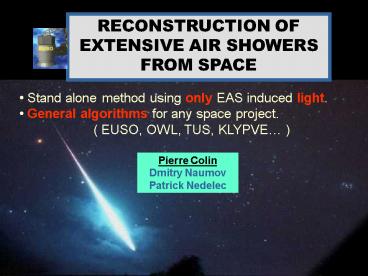Pierre Colin - PowerPoint PPT Presentation
Title: Pierre Colin
1
RECONSTRUCTION OF EXTENSIVE AIR SHOWERS FROM
SPACE
- Stand alone method using only EAS induced light.
- General algorithms for any space project.
- ( EUSO, OWL, TUS, KLYPVE )
Pierre Colin Dmitry Naumov Patrick Nedelec
2
Physics hopes
Purpose Reconstruct initial UHECR parameters
Energy (spectrum)
Direction (UHECR sources map)
Particle type (proton, iron, neutrino, gamma,
etc.)
?
3
Shower parameters
UHECR
Angles (Zenithal ? and Azimuthal f)
Altitude of shower maximum Hmax
Depth of shower maximum Xmax
Total energy released E
E
Xmax
Hmax
?
4
Detection from space
Space telescope
SIGNAL f(t)
UHECR
Fluorescence
Cerenkov echo
Cloud
5
Data fit
Available information for every GTU (Time Unit
2.5 µs)
Number of detected photons Ni
fit 2 Gaussians Fluorescence Cerenkov
constant Background noise
- Monte Carlo data
- - Global fit Fluorescence Cerenkov Background
6
TWO METHODS
Monte Carlo Data
Signal analysis (Trigger conditions) 3 samples
of events
Fluorescence events
Golden events (FluoCer)
Cerenkov events
Reconstruction
7
Hmax reconstruction Cerenkov method
(Classical method)
For golden events
We use Cerenkov echo
Time between Cerenkov and fluorescence
maximum
8
Hmax reconstruction Cerenkov method
Test of the method no cloud events (Hcer 0 )
Reconstructed Hmax vs Simulated Hmax
Relative Erreur
Errorlt10 for ?lt60
Method not efficient for large ? angle
(horizontal EAS)
9
Hmax reconstruction Shape method
(Brand new method)
For Fluorescence event
We use only Fluo signal
emitted photon
?L EAS track length
Fluorescence Yield (ph/m)
Ne charged particles in EAS
Y Fluorescence Light Yield
Y smooth variation with altitude
10
Hmax reconstruction Shape method
For horizontal showers
Total shower lenght L ? ?LGTU xtot / ?(h)
L20100 km
5 km
20 km
Xtot L?(h)
L5 15 km
Ntot ? Ni ? ?Ylt NegtL ? ?YltNegt xtot /
?(h)
Ntot varies dramatically with altitude
11
Hmax reconstruction Shape method
Generalization for all ? angles
Thanks to ? Y smooth variation with altitude
- Approximation
- lt?YNegt? (?Y)max lt Negt
- lt ?(h) gt? ?(Hmax)
Varies like ln(E)
Nmax/Ntot ? ?(Hmax)
?(Hmax)
Hmax
12
Hmax reconstruction Shape method
Test of the method
Reconstructed vs Simulated Hmax
Relative Erreur
Errorlt10 for ?gt60
Good Method to reconstruct large ? angle EAS !
13
Direction reconstruction
Available information for every GTU
Photon incident angles ?ix, ?iy
There is relationship between (?ix,?iy) and (?,f)
angle of EAS.
Reconstruct ?
Reconstruct T
Direction s 2
Simulated ?
Simulated ?
Assuming infinite pixel resolution
14
Xmax reconstruction
(reconstructed Xmax simulated Xmax) (T) in
g/cm2
Golden events
fluorescence events
Hmax by Cerenkov echo
Hmax by shape method
slt5 for ?lt50
s 10
15
Energy reconstruction
for 1020 eV proton s 22
E reconstructed by shape method (fluorescence)
16
Shape method good for UHE neutrinos!
neutrinos
protons
Neutrinos create mainly horizontal EAS without
Cerenkov echo.
17
Conclusion
- We have developed two complementary methods to
reconstruct EAS from space using UV light signal. - using Cerenkov echo
- Efficient for vertical showers (?lt60)
- Need complementary information (echo altitude)
- using only signal shape
- Efficient for horizontal showers (?gt60)
- UHE Neutrino astronomy from space is possible
We can reconstruct any ? EAS 0 to 90 or more
! This first trial is very promising.
18
BONUS SLIDE
19
Simulated data
Available information for every GTU (Time Unit
2.5 µs)
Photon incident angles ?ix, ?iy
Number of detected photons Ni
z
Space telescope
?ix, ?iy EUSO simulation
ay
ax
Extensive air shower
?
Hmax
y
?
x
20
If we add pixel resolution
EUSO simulation
EUSO event on focal plan (M36)
?
Error more from detector than from method
21
Xmax reconstruction
SLAST simulation of Xmax(g/cm2)
Xmax change with RCUE type Xmax f(E/A) (E/A
is energy by nucleon)
Iron
proton
Test with 10 000 protons and 10 000 iron nuclei
Xmax for fluorescence events
Xmax for Golden events
22
Energy reconstruction
Y Fluorescence yield (ph/m)
Kakimoto Model
? Atmosphere transmission
Lowtran Model
e Detector efficiency
?O Detector solid angle
23
Energy reconstruction
24
Detection from space
Space telescope
UHECR
Cloud































